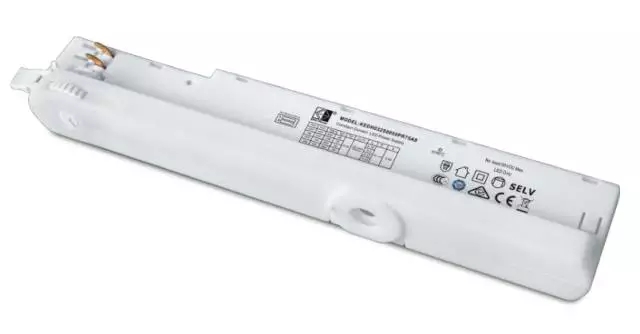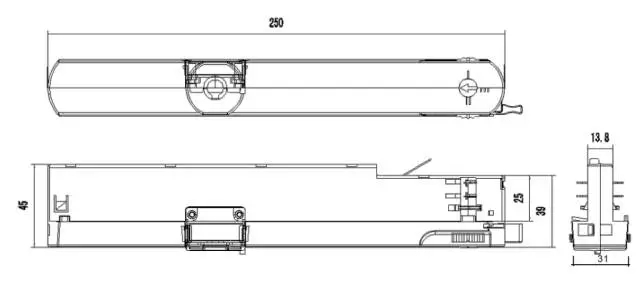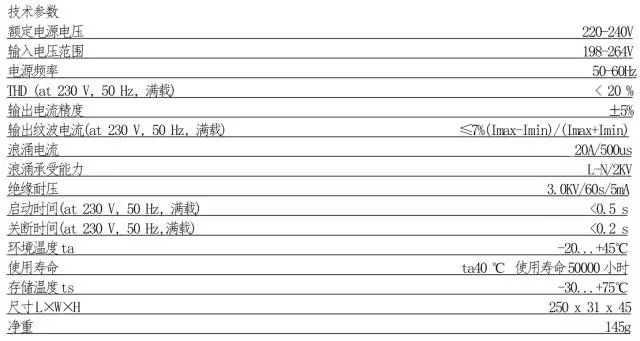Commercial lighting, a product of modern commercial spaces, is a specialized lighting system designed to enhance the visual appeal and functionality of business environments. As the commodity economy and urban development have grown, commercial lighting design has evolved to focus more on aesthetics, modernity, and customer engagement. It now plays a key role in capturing customer attention, guiding shopping behavior, and creating a pleasant retail atmosphere.
In response to varying lighting needs across different commercial settings, a wide range of lighting fixtures have emerged. Among them, track lights have gained significant popularity due to their sleek design and flexibility. These lights are typically used for localized illumination, emphasizing mobility and ease of installation, making them ideal for highlighting specific areas or creating a unique ambiance.
To meet the rising demand for track lights, Kegu Power has introduced an innovative trackless lamp integrated stroboscopic power supply. According to Gaogong LED, this power supply allows users to adjust output power via a DIP switch, offering four current modes: 650, 750, 800, and 850mA. The maximum output power can reach up to 34W, providing versatile options for various applications.

Kegu Power's trackless lamp power supply represents a breakthrough in traditional track lighting systems. By integrating the track head and power supply into one unit, it significantly reduces assembly costs by 60%. This design eliminates constraints related to power supply size and heat dissipation, improving overall stability. The power supply also features high power factor, no flicker, and other advanced electronic characteristics. Additionally, it offers greater freedom in lamp design since it is no longer limited by conventional components.

The power supply housing is made from PC (polycarbonate) material, achieving a fire rating of 94-V0 and complying with RoHS standards. The contacts are crafted from copper alloy, ensuring excellent electrical conductivity. The power supply meets IP20 protection level and is certified by TUV, CE, SAA, and CCC. It also passes a 2kV surge test and complies with EN 61347-2-13 C5E standards for temperature protection. With a long lifespan of 50,000 hours and a five-year shelf life, it ensures reliable performance over time.

This power supply includes multiple safety features such as overload, short-circuit, no-load, and undervoltage protection. It also successfully passes the glow wire test at 750°C, meeting the EN61347-1 standard. Here’s a breakdown of its protection functions:
**Overload Protection**: If the output voltage exceeds the LED driver's range, the system will reduce the current or enter burst mode. Once the overload condition is resolved, it automatically resumes normal operation.
**Short-Circuit Protection**: In the event of a secondary-side short circuit, the power supply turns off. It restarts automatically once the issue is fixed.
**No-Load Protection**: When the LED source is disconnected, the power supply maintains a constant output voltage and operates in burst mode to ensure safe operation.
**Undervoltage Protection**: If the input voltage drops below 150–170VAC, the power supply activates protection and turns off.
Due to its outstanding performance and competitive edge, Kegu Power has entered the “2017 (8th) High-Tech LED Golden Globe Awards†with this innovative product.
**About Kegu Power**
Guangdong Kegu Power Co., Ltd. is a high-tech enterprise specializing in LED driver power supplies. The company integrates R&D, production, sales, and service, focusing on developing independent LED power sources that are stable, efficient, and flicker-free. Its products feature multiple protections and are certified by ENEC, CCC, UL, TUV, CE, CB, SAA, SEMKO, and RoHS.
Covering over 33,000 square meters, the company employs dozens of senior engineers and has achieved ISO9001:2015 certification. It uses an advanced ERP system and implements full traceability through barcodes. With continuous process optimization and external consulting, Kegu Power constantly enhances its management efficiency and product competitiveness.
Dedicated to becoming the most reliable LED driver solution provider globally, Kegu Power strives to exceed customer expectations through innovation, quality, and exceptional service. With cutting-edge technology, efficient operations, and superior support, the company aims to establish itself as a leading global brand in the LED lighting and power supply industry.



TV Antenna, also commonly referred to as a television antenna, stands as a pivotal element in the realm of television signal reception. It functions as a bridge between the broadcasting towers and your television set, enabling viewers to access a myriad of television channels and indulge in a vast array of programming content. This versatile device harnesses the power of electromagnetic waves to capture and convert signals into viewable images and sounds, offering a seamless entertainment experience.
1. Purpose and Functionality
Reception of Television Signals: The primary function of a TV Antenna is to capture and convert radio frequency (RF) signals from television broadcasting stations into electrical signals that can be processed by a television receiver or set-top box.
Multi-Band Support: Depending on the model and design, TV Antennas can be tuned to different frequency bands, including those used for terrestrial television broadcasts (e.g., VHF, UHF) and in some cases, even satellite television signals.
2. Types and Designs
Outdoor Antennas: Typically mounted on rooftops or exterior walls, outdoor TV Antennas offer better reception due to their higher positioning and ability to capture signals from a wider area. They come in various shapes and sizes, including parabolic dishes for satellite TV and yagi-uda arrays for terrestrial signals.
Indoor Antennas: Designed for placement inside the home, indoor TV Antennas are more convenient and often easier to install. They can be flat panels, rabbit ears, or amplified versions that enhance signal strength.
Specialized Antennas: There are also specialized TV Antennas for specific applications, such as marine or RV use, which are designed to withstand harsh environments and provide reliable reception while on the move.
3. Technical Specifications
Frequency Range: The frequency range supported by a TV Antenna determines which television channels it can receive. For example, a TV Antenna designed for terrestrial broadcasts may cover the VHF (54-216 MHz) and UHF (470-862 MHz) bands.
Gain: Gain is a measure of an antenna's ability to direct and amplify received signals. Higher gain values typically result in better reception, especially in areas with weak signal strength.
Polarization: Antennas can be polarized in different ways (e.g., horizontal, vertical, circular) to match the polarization of the transmitted signals. Proper polarization is crucial for optimal reception.
Directivity: Some TV Antennas are highly directional, focusing their reception pattern towards a specific direction or satellite. This can be advantageous in areas with multiple broadcasting stations or in reducing interference from unwanted signals.
4. Applications
Home Television Reception: The most common application of TV Antennas is for receiving television signals in residential settings. With the rise of digital television and cable/satellite services, the use of traditional TV Antennas has declined, but they are still popular in areas with limited access to these services.
Mobile Reception: Specialized TV Antennas are used in vehicles (e.g., RVs, boats) to provide television reception while on the move. These antennas are designed to withstand harsh environments and maintain reception even while traveling.
Commercial and Institutional Use: TV Antennas are also used in commercial and institutional settings, such as hotels, hospitals, and schools, to provide television services to multiple users.
1. Purpose and Functionality
Reception of Television Signals: The primary function of a TV Antenna is to capture and convert radio frequency (RF) signals from television broadcasting stations into electrical signals that can be processed by a television receiver or set-top box.
Multi-Band Support: Depending on the model and design, TV Antennas can be tuned to different frequency bands, including those used for terrestrial television broadcasts (e.g., VHF, UHF) and in some cases, even satellite television signals.
2. Types and Designs
Outdoor Antennas: Typically mounted on rooftops or exterior walls, outdoor TV Antennas offer better reception due to their higher positioning and ability to capture signals from a wider area. They come in various shapes and sizes, including parabolic dishes for satellite TV and yagi-uda arrays for terrestrial signals.
Indoor Antennas: Designed for placement inside the home, indoor TV Antennas are more convenient and often easier to install. They can be flat panels, rabbit ears, or amplified versions that enhance signal strength.
Specialized Antennas: There are also specialized TV Antennas for specific applications, such as marine or RV use, which are designed to withstand harsh environments and provide reliable reception while on the move.
3. Technical Specifications
Frequency Range: The frequency range supported by a TV Antenna determines which television channels it can receive. For example, a TV Antenna designed for terrestrial broadcasts may cover the VHF (54-216 MHz) and UHF (470-862 MHz) bands.
Gain: Gain is a measure of an antenna's ability to direct and amplify received signals. Higher gain values typically result in better reception, especially in areas with weak signal strength.
Polarization: Antennas can be polarized in different ways (e.g., horizontal, vertical, circular) to match the polarization of the transmitted signals. Proper polarization is crucial for optimal reception.
Directivity: Some TV Antennas are highly directional, focusing their reception pattern towards a specific direction or satellite. This can be advantageous in areas with multiple broadcasting stations or in reducing interference from unwanted signals.
4. Applications
Home Television Reception: The most common application of TV Antennas is for receiving television signals in residential settings. With the rise of digital television and cable/satellite services, the use of traditional TV Antennas has declined, but they are still popular in areas with limited access to these services.
Mobile Reception: Specialized TV Antennas are used in vehicles (e.g., RVs, boats) to provide television reception while on the move. These antennas are designed to withstand harsh environments and maintain reception even while traveling.
Commercial and Institutional Use: TV Antennas are also used in commercial and institutional settings, such as hotels, hospitals, and schools, to provide television services to multiple users.

TV Antenna,indoor tv antenna,digital tv antenna,car satellite dish tv antenna,tv antenna hdtv
Yetnorson Antenna Co., Ltd. , https://www.yetnorson.com